
Hermannsburg
Hermannsburg is a mission station in the Natal Midlands. It is named after the Hermannsburg in Germany which was the headquarter, and still is, of the Hermannsburg Mission Society. This Hermannsburg is located at 29.0426°S, 30.7925°E and 1167m, it is 23km from Greytown.
History
The history of the Hermannsburg mission station had its beginning in Hermannsburg in Germany. That is where Ludwig (or Louis) Harms started the Hermannsburg Mission Society in 1849. He started training people for mission work and also had a sailing vessel built to take the new missionaries to all corners of the globe.
 The first journey of the Kandeze carrying 16 brethren was undertaken in 1854, that was to East Africa, Ethiopia more specific. On the way they stopped over in Cape Town where the captain took on some cargo to be taken to Durban. Thus requiring another stop at Durban. Here they made the acquaintances with a group of Germans at New Germany.
The first journey of the Kandeze carrying 16 brethren was undertaken in 1854, that was to East Africa, Ethiopia more specific. On the way they stopped over in Cape Town where the captain took on some cargo to be taken to Durban. Thus requiring another stop at Durban. Here they made the acquaintances with a group of Germans at New Germany.
But they had to press on and reached their destination at Mombasa to find that the Iman was not interested in giving them permission to pass through his territory. Here they also met another Missionary, Johannes Rebmann, who suggested to go back to Natal and to rather target the Zulus there. Thus their mission not accomplished they went south again and landed at Durban.
Initially settling among the Germans in New Germany they were advised by Rev Posselt to do mission work in Zululand. A delegation was sent to Missionary Schreuder from the Norwegian Mission Society who had a station in King Panda's territory. He offered to accompany them to see the king, but also advised that it would be highly unlikely that they will be granted permission to settle in the territory. The best would be to establish a station in the colony and to work from there.
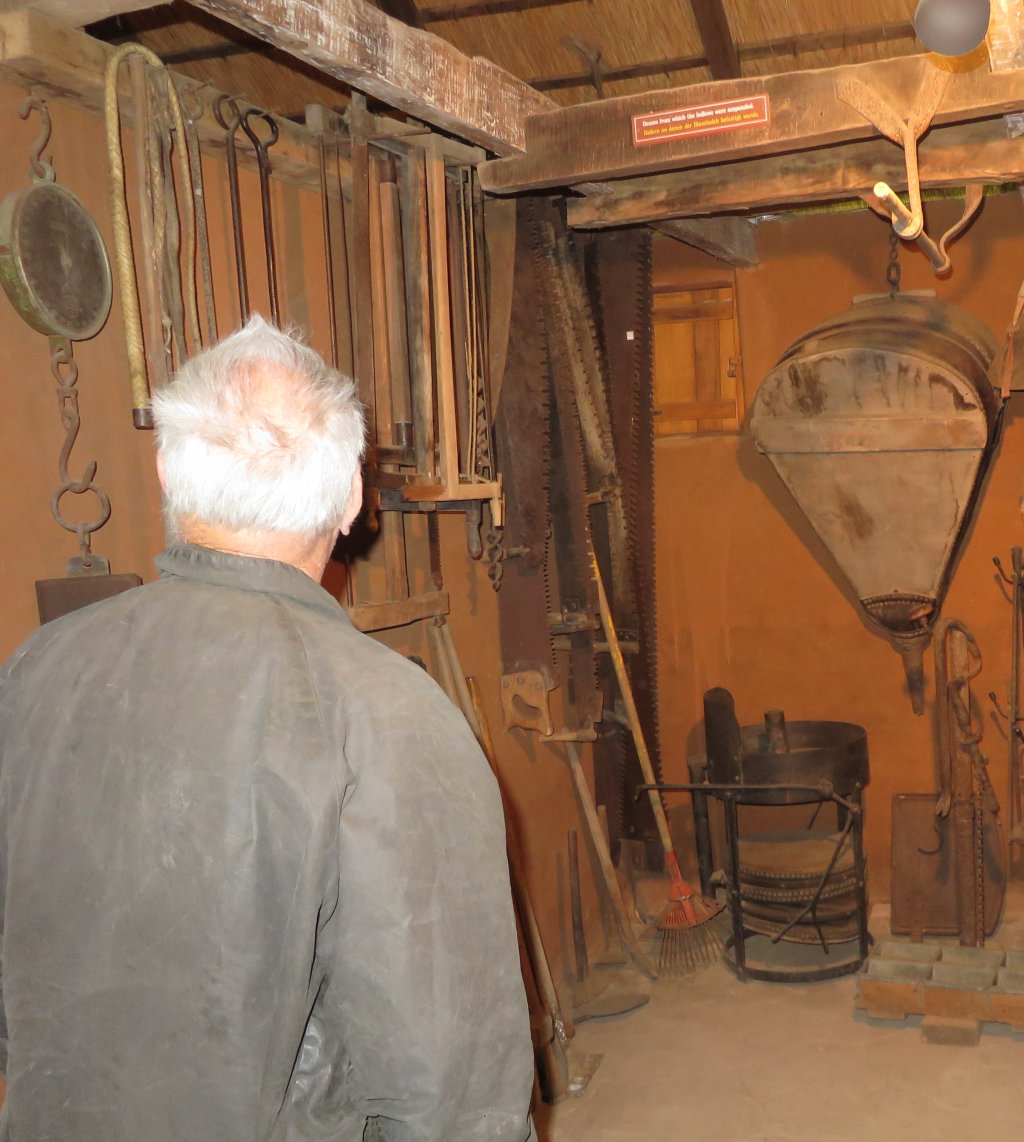
 Back in New Germany they met up with Mr.Berends, a German from Hamburg who was in the service of the colonial administration. He sold them his farm 'Perseverance' of 6018 acres in exchange for £630. This became Hermannsburg, or Neu-Hermannsburg as they called it initially.
Back in New Germany they met up with Mr.Berends, a German from Hamburg who was in the service of the colonial administration. He sold them his farm 'Perseverance' of 6018 acres in exchange for £630. This became Hermannsburg, or Neu-Hermannsburg as they called it initially.
In November 1854 the bretheren moved to the farm and immidiately started farming and building accomodations. The first solid structure was the kitchen and the smithy.
Museum
That first building, the kitchen and the smithy, is still there and part of the museum. 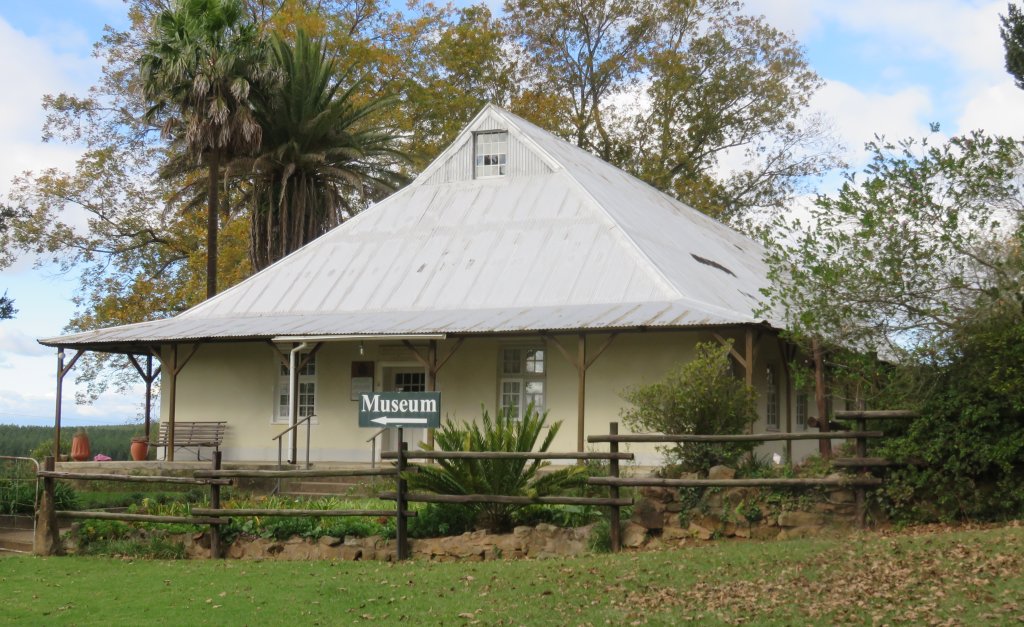 The construction of the 'big house' was started in 1855 and completed in September the same year. This was to be where everybody would live, it had 25 rooms consisting of two bedrooms to a lounge, as well as a dining room and a provisional church.
The construction of the 'big house' was started in 1855 and completed in September the same year. This was to be where everybody would live, it had 25 rooms consisting of two bedrooms to a lounge, as well as a dining room and a provisional church.
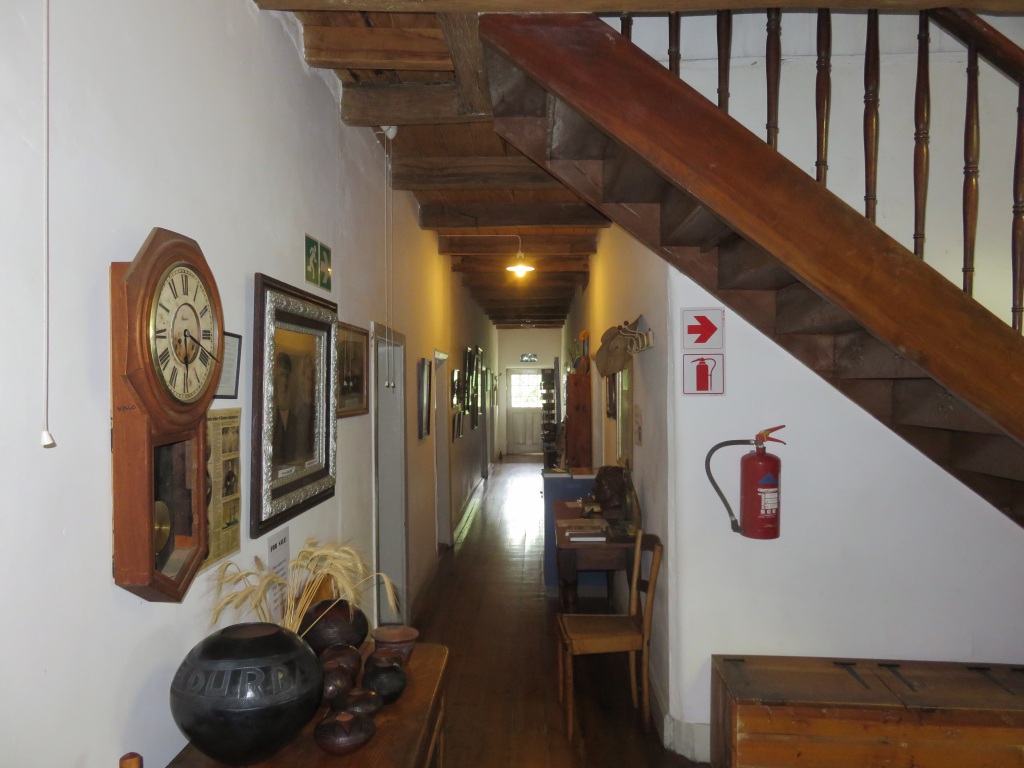 Everything that went into the construction was sourced locally. The rafters, beams and boards were cut from local trees. Some of the brethren spend weeks in the forest to cut down trees and to saw and plane the timber into the required shape. Stones were sun dried mud bricks made on site. The grass for the roof had to be cut with sickles.
Everything that went into the construction was sourced locally. The rafters, beams and boards were cut from local trees. Some of the brethren spend weeks in the forest to cut down trees and to saw and plane the timber into the required shape. Stones were sun dried mud bricks made on site. The grass for the roof had to be cut with sickles.
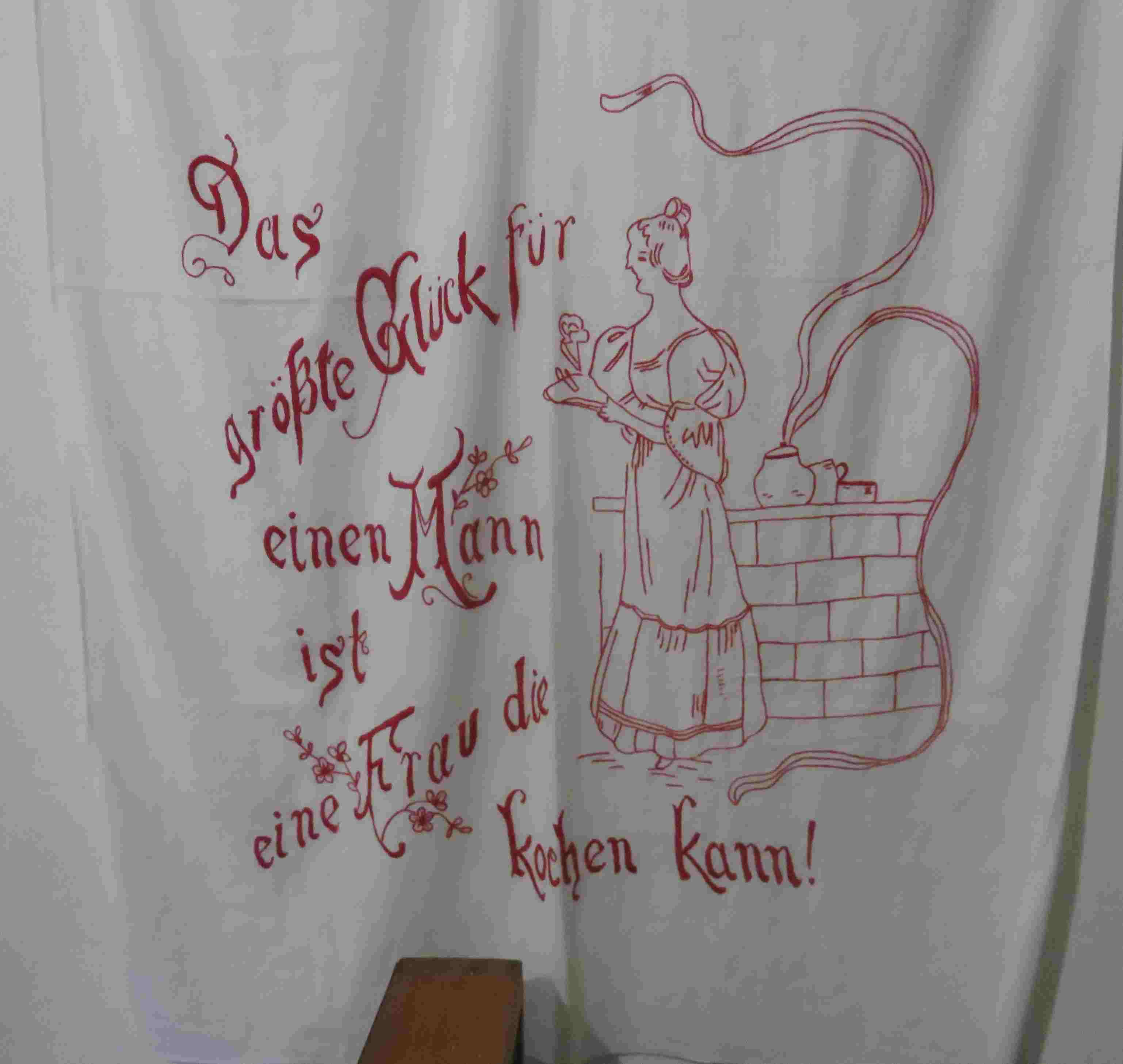 One has to marvel at the quality of workmanship when looking at the beams and boards, considering that all that had to be cut and worked using basic hand tools under sometime difficult conditions. Everything is straight and smooth.
One has to marvel at the quality of workmanship when looking at the beams and boards, considering that all that had to be cut and worked using basic hand tools under sometime difficult conditions. Everything is straight and smooth.
The whole house is now a museum, explaining the history of the settlement and having a variety of exhibits. The one I like to share is an embroidered kitchen towel. 'Das Größte Glück für einen Mann ist eine Frau die kochen kann', translated 'the best luck for a man is a wife that can cook'. This should have the feminists jumping up and down.
Lutheran Church
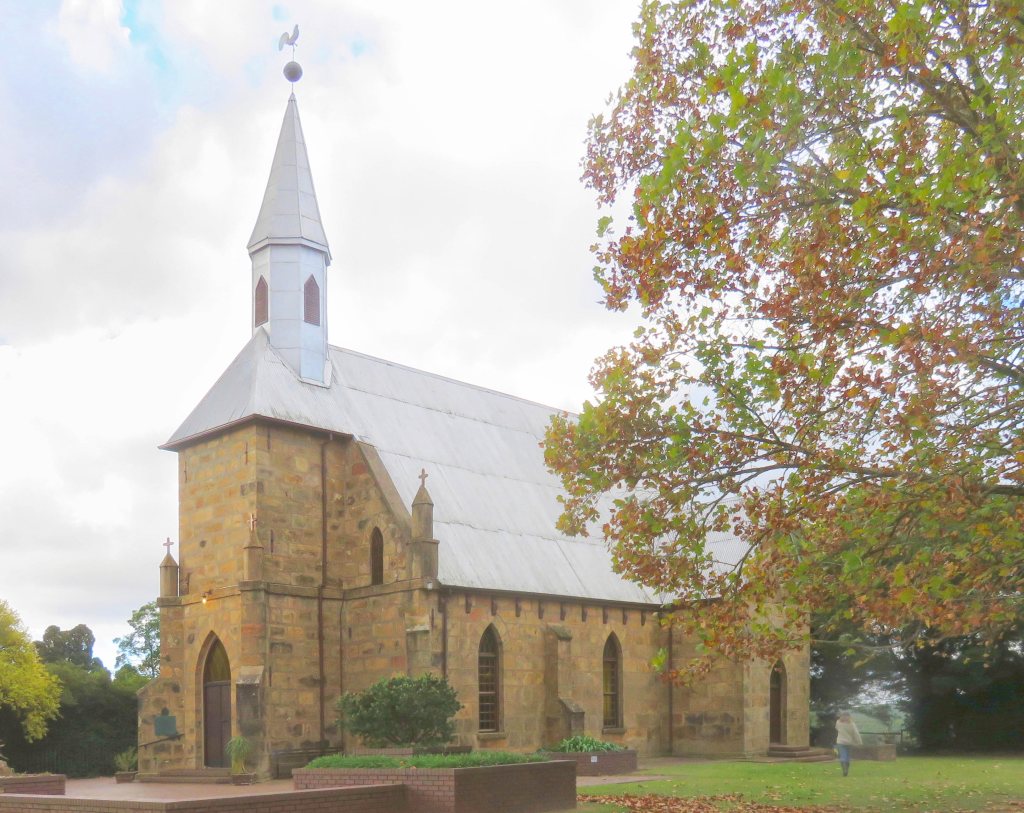 The plan of the big house showed one room to be used as a church, that was until 1860 when a small church was build. With growing numbers that church was soon too small and in 1868 the foundation stone for a big sand stone church was laid. This is the church still in use today.
The plan of the big house showed one room to be used as a church, that was until 1860 when a small church was build. With growing numbers that church was soon too small and in 1868 the foundation stone for a big sand stone church was laid. This is the church still in use today.
I make it easy on myself and just copy the information plague at the church.
EV.-LUTH. PETER PAUL CHURCH, HERMANNSBURG
The foundation stone of this neo-gothic church was laid
on 1.April 1868. The building was consecrated on 23.February
1870. On 5.May 1872, after a period of continuous rain, the
tower collapsed. But was rebuilt in a modern fashion
During September 1872. The building is closely associated
with the founding of the Hermannsburg Mission Society in
South Africa and the history of the German settlers in Natal.
 National Monuments Council
National Monuments Council
Not mentioned on the plaque is that the foundation stone was laid by Heinrich Karl Hohls (*22-6-1827 ✝22-6-1883), who was the Superintendent of the Mission in South Africa from 1864 to 1883. His remains are buried in the old cemetery.
The old church and the new church were used for both language groups, a service in Zulu and a service in German. That was until 1925 when a separate Zulu church was built.
 As stated above the building is in the neo-Gothic style, but more than that it is very typical of churches in the north-west area of Germany, striking is mainly the shape of the tower. There is no information of who was the architect or who designed it. On the inside it is kept in the plain Lutheran style. It has an organ, I could not get to the name plate, it looks fairly new. Of interest was the lock of the front door, it has never been changed and is as it was made by the smithy in Hermannsburg at the time. It looks like some repairs have been done to it.
As stated above the building is in the neo-Gothic style, but more than that it is very typical of churches in the north-west area of Germany, striking is mainly the shape of the tower. There is no information of who was the architect or who designed it. On the inside it is kept in the plain Lutheran style. It has an organ, I could not get to the name plate, it looks fairly new. Of interest was the lock of the front door, it has never been changed and is as it was made by the smithy in Hermannsburg at the time. It looks like some repairs have been done to it.
School
The school was started in 1856 and that was in one of the rooms in the big house. The first teacher was Heinrich Müller, he had three pupils, Karl, the son of Sarah (see further down) and Christine and Johann, two children of Kleinbooi who came to Natal with the Voortrekkers and was now living at Hermannsburg. In his report Heinrich said that initially it was a difficult task to instill any discipline into the children. His work was taken over by Heinrich Hohls
Cemeteries

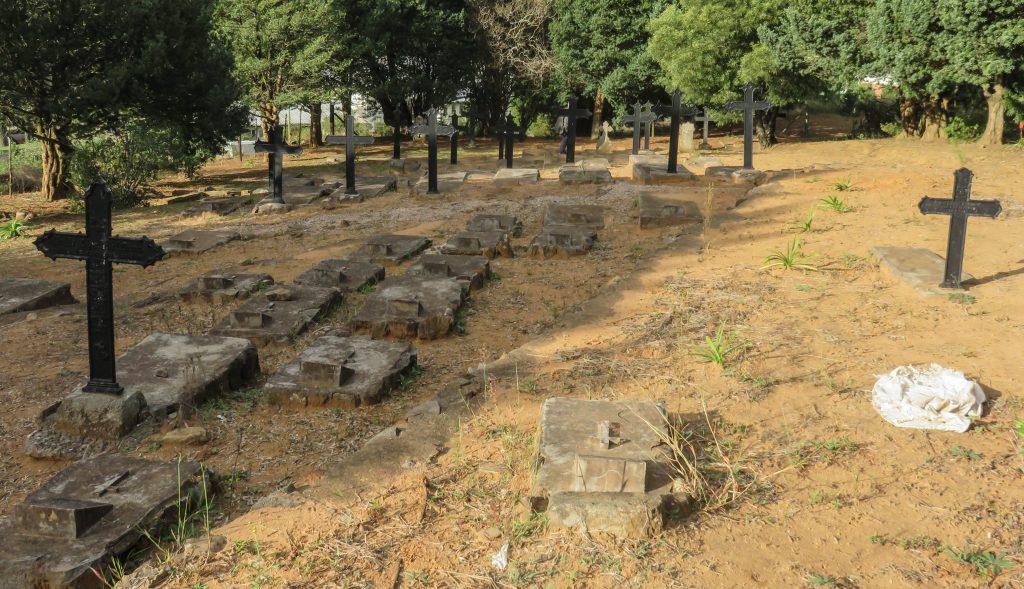 There are two. Next to the church is the newer one and a bit down the hill the Alte Friedhof, that is what the sign indicates. But don't follow that sign, it leads you into the veld, rather ask for directions.
There are two. Next to the church is the newer one and a bit down the hill the Alte Friedhof, that is what the sign indicates. But don't follow that sign, it leads you into the veld, rather ask for directions.
The earliest grave is that of Sarah Maria Kumalo. She arrived at the station with her husband and child in the early days of the station. They both desired to be baptised and had their child baptised first. Her husband changed his mind and left. She stayed on and worked in the kitchen and prayed that her husband would return, which he did and both of them were baptised. She died of dropsy on the 3-Feb-1856 and was the first to buried in the old cemetery.
A grave that interests me is that of GM Green of the Isipingo Mounted Rifles who died on the 12-6-1876 aged 18. I have not found anything on the circumstances of his death. Perhaps somebody from Hermannsburg can help me.
References
Ref 1.: Lutherans, Germans:Hermannsburgers, Natalia 22 (1992), H-J. Oschadleus (enter the title as a search term to find the article)
Ref 2.: Udo S. Küsel, Africa Calling - a cultural history of the Hermannsburg Mission and its descendants in South Africa, published by African Heritage Consultants cc, 2017